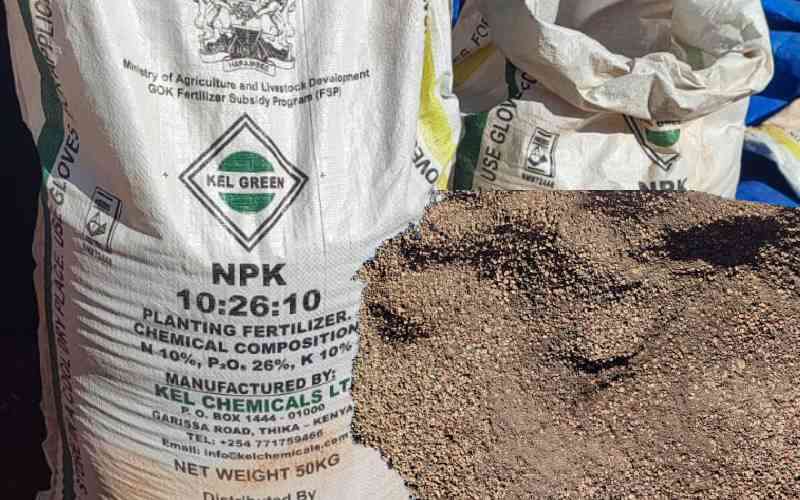NAIROBI: Standards have everything to do with our day-to-day lives. From the end user who purchases a product to the manufacturer whose goal is to expand his business within and without the border. Whether at home or at office, from the food that you consume, to the car that you drive and even the road that you are driving on, we interact with standards every day. In today's world, standardisation is playing an increasingly important role in the global economy.
That "the world runs on standards" underpins the importance of standards in the economic development of any nation. Over the last few decades, it has developed from an instrument of justification within organisations to become a strategically relevant instrument for entering and occupying globalised markets.
As Kenya prepares to mark the African Day of Standardisation, next week, the nation and region needs to re-evaluate how we use standardisation to ensure our goods and services compete at the global level.
Hence, begs the question, how does standardisation promote sustainable agriculture? The theme of the day is the role of Standards in promoting sustainable Agriculture and food security in Africa. Currently across Africa, crop failure is increasing as a result of erratic weather patterns and poor quality seeds, among other factors.
According to Food and Agriculture Organisation (FAO), while it is estimated that more than 75 per cent of the African local cereal production is provided by small-scale farmers, only a fraction of these farmers are trained/educated in Quality Management of their crops. This results in post-harvest losses estimated to be about 30 per cent annually in the sub-Saharan region in Africa.
As the country grapples with erratic weather patterns, there is need for the sector to make changes on how it approaches agriculture. Growing sufficient food requires people to make switches such as increasing productivity in areas dependent on rain-fed agriculture; improving soil fertility management; expanding cropped areas; investing in irrigation; conducting agricultural trade between countries; and reducing post-harvest losses.
Enhancing access and utilisation of high quality seeds is a core component to realising this strategy. Compared to other agricultural inputs, seed has been shown to have the greatest potential to increase on-farm productivity and enhance food security and nutrition.
Despite the growing importance of quality standards, evidence shows that poor access to markets is increasingly threatening the ability of smallholder farmers to compete with large-scale commercial farmers. Standards can be used to manage these causes of imbalance especially with regard to aflatoxin management.
For the country to gain from standardisation, each player at every level has to apply good practices which ultimately contribute to food safety and quality. Farmers must apply Good Agricultural Practices (GAP). Sellers of commodities/raw materials at the local or international levels must apply Good Distribution Practices (GdP), and manufacturers must apply Good Manufacturing Practices (GMP).
In the East African Community, lack of harmonised standards has led to the recognition of the need to synchronise regulatory policies, sanitary and phyto-sanitary issues, and standards to help implement the special trade regime for cross-border trade.
Promoting consistency and harmonisation of quality standards for agricultural products will help facilitate trade and promote greater transparency across the value chain. By observing high standards in our operations, the benefits will see small-scale farmers adopt technology that will see an increase in crop production hence greater regional food security.
The Integrated Food Production Intervention (IFPI) report that was released last year, indicates that globally, the rate of growth in yields of the major cereal crops has been steadily declining – from 3.2 per cent per year in 1960 to 1.5 per cent in 2000.
The challenge for standardisation and technology, therefore, is to reverse these declining food needs by applying standardisation measures for innovations and research to address the optimal use of genetic resources. Additionally, adoption of species diversification to produce improved indigenous varieties of high-value seeds that improve productivity through higher yields and/or greater adaptation to the tropical climate and resistance to biotic and abiotic stresses.
 The Standard Group Plc is a
multi-media organization with investments in media platforms spanning newspaper
print operations, television, radio broadcasting, digital and online services. The
Standard Group is recognized as a leading multi-media house in Kenya with a key
influence in matters of national and international interest.
The Standard Group Plc is a
multi-media organization with investments in media platforms spanning newspaper
print operations, television, radio broadcasting, digital and online services. The
Standard Group is recognized as a leading multi-media house in Kenya with a key
influence in matters of national and international interest.
 The Standard Group Plc is a
multi-media organization with investments in media platforms spanning newspaper
print operations, television, radio broadcasting, digital and online services. The
Standard Group is recognized as a leading multi-media house in Kenya with a key
influence in matters of national and international interest.
The Standard Group Plc is a
multi-media organization with investments in media platforms spanning newspaper
print operations, television, radio broadcasting, digital and online services. The
Standard Group is recognized as a leading multi-media house in Kenya with a key
influence in matters of national and international interest.








